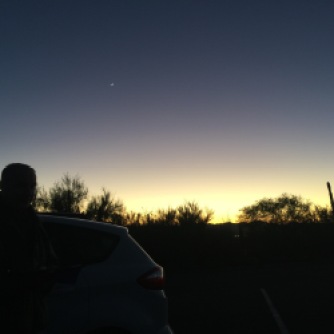As winter approached, we headed south. Outside of Tucson, we chose the highly recommended Gilbert Ray Campground as basecamp for a visit to Saguaro National Park.

Airstream tucked in at Gilbert Ray Campground, near the Tuscan Mountain District (western) part of Saguaro National Park.
You know how some ranger talks are better than others? It felt like Bob gave us the keys to the desert – slowly, carefully teaching us about the various plants, one at a time. He explained how they worked together, and how by looking closely, they’d reveal even more about their desert existence, and help you make sense of the place.

Our hero: Bob. In his hiking pack, he carries, among other things, a comb, in case he or a visitor gets stuck by a jumping cholla (choy-a) cactus ball. Also, a camera, because as long as he’s been out in the desert, there are still some things he hasn’t seen (e.g. certain kind of scorpions) and would like to.

In this picture, one can see palo verde, saguaro, cholla, and prickly pear. Probably a lot more.

After getting schooled by Bob, we were able to go out and find our own saguaro cacti. On the left, is a younger saguaro, maybe about my age. 🙂 The one I’m gazing up at could be 200 years old.

Ben atop the Hugh Norris Trail, saguaro on his left, ocotillo (which look like a fountain) on the right

We scratched our astronomy itch instead at a program that the folks at Kitt Peak sponsored, but held in the parking lot of the visitors center back at Saguaro: a night-time Binoculars Stargazing program. Ben and I ended up being the only attendees, so we got a lesson on how to use a star map, tips on using our binoculars effectively, and a personal tour of the night skies. Our guide also gave us resource recommendations for future exploration: download the (free) monthly star guide from SkyMaps.com for a map showing where the starts will be. He also recommended a book for newbie skygazers, young and old: The Monthly Sky Guide, which Santa brought to Ben for Christmas.
Some highlights of what we learned (hopefully translating it correctly):
-There are only 88 constellations in the sky – and they are entirely human creations.
-The North Star – what we know as Polaris – changes. It’s not always Polaris. It’s whatever (bright) star is closest to being directly overhead if you are standing on the earth’s north pole. But Polaris’s position relative to the North Pole is slowly drifting, so eventually (500 years or so) Polaris will no longer serve that role.
-Stars with a blue tint are actually hotter than those with a red tint.
-Ever wonder why your particular astrological sign is in a particular month? Nope, it’s not because you can see your birth month constellation during your birth month. During your birth month, the sun is passing through your constellation, so you can’t see it in the night sky.
We spent a little time in the town of Tucson for some R&R and to do errands. Some of the locals shared that Tuscon is well ahead of other cities -Phoenix, for example – when it comes to things like planning for drought and eliminating light pollution (light pollution is a big deal – affects astronomers, of course, but also animals that require dark skies for hunting, etc.) Tucson is home of the University of
 Arizona, and Cactus League Spring Training. We saw the excellent movie Spotlight, and had Korean food at Kimchi Time where I had the very odd but kind of cool experience of having one of the waitresses walk right up to me and say “You look just like my mom! You even dress like her!” Now, as a non-mom, this was a little strange to hear, and most of my friends’ kids aren’t quite as old as this young woman, so that was a little disconcerting. (Plus, what about the “you dress like her” comment?) But she was so sweet, we took pictures together, found some more things in common and are now following each other on IG.
Arizona, and Cactus League Spring Training. We saw the excellent movie Spotlight, and had Korean food at Kimchi Time where I had the very odd but kind of cool experience of having one of the waitresses walk right up to me and say “You look just like my mom! You even dress like her!” Now, as a non-mom, this was a little strange to hear, and most of my friends’ kids aren’t quite as old as this young woman, so that was a little disconcerting. (Plus, what about the “you dress like her” comment?) But she was so sweet, we took pictures together, found some more things in common and are now following each other on IG.
On another personal note, we spent a lot of our time in this spot worrying about one of our kitties, who had/has a health scare, but seems to be doing ok now in the hands of his loving DC family: Laura, Mark, Logan and Finn. But do keep the very handsome orange kitty Gordo in your T’s and P’s.








As I’m sure you have already heard you missed a huge snow storm. We are so thankful that we didn’t lose power and that it didn’t flood. There is a full moon and with high winds flooding was expected. As laways glad to hear from you-stay safe.
LikeLike